SEO
How to Write Better Content Faster

What if I told you that you could write faster, better, and in a way that increases your odds of ranking highly on Google’s search results?
Well, you can—with content outlines.
Outlining your content can improve your writing efficiency and content flow, as well as ensure you include the required bits for SEO in every article.
I’ve personally outlined thousands of articles over the last 10 years, and it’s been the key to keeping up with the constantly changing pace and need for ever-more and ever-better content.
In this guide, you will learn the following:
A content outline is a detailed overview of what your article will include.
My outlines always include the headings and subheadings of the article (H2s, H3s, etc.). The outlines also include a look at the competing content in Google and important questions to address or long-tail keywords to be included.
They also include things like the goal of the article, the approach angle, the unique selling proposition, and more. We’ll look at these in more detail later in the section discussing how to outline your content. But first…
I always draft an outline before I start writing an article. This is for several reasons:
- An outline guarantees you include important things for search engine optimization (SEO) – These include having the right keywords and satisfying the searchers’ intent by addressing their most common questions.
- An outline helps you improve the flow of your article before you start writing – If you just dive into the writing, your ideas can be all over the place and you may have to spend a lot of time reorganizing the information to be more logical… and this process can be a nightmare without an outline.
- You can more easily outsource content at scale with proper outlines – With a great outline, even a mediocre writer can produce great content. If you want to scale up your content production with any level of quality control, good outlines are a necessity.
So how do you write a great content outline?
Click here to make a copy of our content outline template.
This template includes everything you need to properly outline your blog articles, including the:
- Target keyword.
- Search intent of your target keyword.
- Approach angle.
- Goal of your content.
- Unique selling proposition (USP).
- Title of the article.
- Headings and subheadings of your content.
Don’t worry if any of the above confuses you. I’ll break down what each means in the next section.
Luckily, outlining content is fairly easy once you learn the process. I break down each section of our template outline below:
1. Decide on the goal of your article
Before you do any research or put down any words, the first step is to decide why you’re even creating this piece of content to begin with.
Your content can have many goals, such as:
- Increasing brand awareness.
- Explaining use cases for your product(s).
- Building backlinks for SEO.
- Growing your email list.
- Ranking for keywords on Google to grow traffic.
- Etc.
Throughout this guide, I’ll be using ramen noodles as an example.
So let’s say I want to write an article about how to make amazing ramen noodles. My goal is to promote my fake company’s amazing hoisin sauce and build brand awareness. So I put that in under my “goal” section:

2. Pick your target keyword
I never write an article without doing some basic keyword research first. Even if the intention of your article isn’t to rank for keywords on search engines, having SEO built into every article you write is still good practice.
Why?
Because it guarantees you build good habits. You may even be surprised at how much extra traffic you can gain—even from keywords that get almost no searches.
For example, I wrote an article about the best places to travel, and its goal was to get links from well-known travel blogs.
While outlining, I targeted the keyword “best places to travel in the world,” which gets about 1,500 searches per month. That article is now ranking for over 200 keywords and gets Google traffic even though SEO wasn’t the goal.


You can easily perform simple keyword research like this by putting keywords related to what you want to write about into Ahrefs’ Keywords Explorer and browsing the results.
For our article about how to make the best bowl of ramen noodles, I start by searching for “ramen noodles” in Keywords Explorer:


You can see it gets a whopping 143,000 searches per month. That’s awesome—however, we need to see if our article idea can actually rank for this keyword.
Scroll down, and you’ll see that the search results in the SERP overview consist of two product pages (Maruchan and Amazon). Those are followed by some extremely authoritative websites:


In other words, unless you already have a strong website, ranking for this keyword with a guide on how to make ramen noodles will be difficult.
Next, scroll back up and look at the Keyword ideas panel. Here, you’ll see other ideas for potential keywords to target, such as “how to make ramen noodles.”


If we look at the Overview page for “how to make ramen noodles,” we can see it may be a bit easier to rank highly on Google for this keyword because the competitors aren’t as strong.
In fact, the featured snippet website has a Domain Rating (DR) score of just 20, which signals that even a newer website with fewer backlinks can likely rank for this keyword.


And that’s how you do basic keyword research! Put your target keyword into your outline, and let’s look at search intent.
3. Research your keyword’s search intent and article angle
Search intent is the why behind a search query. Why did the user search for this keyword? What are they looking for?
Search intent is important because it determines the kind of content you should create for a given keyword. There are four primary types of search intent:
- Informational
- Navigational
- Transactional
- Commercial investigation
Refer to our guide to search intent for more information on each of these. For now, let’s continue with the example we used above on “how to make ramen noodles.”
This is an informational keyword. The searcher is looking for information on how to do something.
Most of the articles you will write are going to either have informational intent (what, how, when, etc.) or commercial investigation intent (like “best X” or “X vs Y”). Navigational intent and transactional intent are for other pages on your site, not blog articles.
But search intent goes beyond simply writing “informational” in a section and calling it a day. That’s where the angle of your content comes in.
What is the angle your competitors are using?
For example, if we look at “how to make ramen noodles,” we see that the top result talks about how to make ramen noodles from scratch. Other results talk about homemade ramen noodles.


The two angles here are making the actual noodles yourself or using prepackaged noodles but making them better with other ingredients. The former is ranking higher on Google, but either angle can work.
As long as you use one of these two approaches, you increase your odds of ranking on page #1 of the search results.
Now research the SERPs and use the “search intent and content angle” section to indicate what kinds of content are currently ranking and what angle YOU want to take with this article.
Here’s how mine looks:


4. Decide on a USP and title
Your USP is what makes your content different from your competitors (and, thus, makes your article worth clicking on over theirs).
Oftentimes, your USP is made obvious by your title, which is why these steps are mixed together. Let’s look at the USPs of our competitors:


Many of their titles show exactly what you’ll get from them over everyone else, such as these:
- Easy Ramen Noodles
- Ramen Noodles in the Microwave
- Perfect and Instant Ramen Noodles
The one that displays its USP the best, however, is the featured snippet result: Ramen Noodles From Scratch (the No-Knead Easy Way).
This article makes two big promises in the title: The ramen is easy and from scratch—both of which seem to be what searchers are looking for.
Think about how you can make your article stand out among the crowd like these guys did. Dig into the SERPs and the “People Also Ask” boxes to try and determine what the searchers are going after. Read forum posts like those on Reddit and try to find ways you can address problems people are having that your competitors aren’t talking about.
For my “ramen noodles” post, my USP is that our ramen is both from scratch and can be improved with better ingredients (something searchers seem to care about). I can also try a slightly different angle and go for authenticity to stand out from the crowd.
Some title ideas can be:
- How to Make Ramen From Scratch (The Easier, Better Way)
- How to Make Authentic Japanese-Style Ramen Noodles
- This Is Exactly How to Make the Most Delicious Ramen Noodles
I always suggest brainstorming multiple title ideas. Then pick what you feel is the best one. This is because your title is so important for getting higher rankings and more traffic.
Check out this guide to writing the best blog titles for more information.
5. Outline your article with headings and subheadings
Here’s where the bulk of the outline work comes in. Choosing headings, ordering those headings, and explaining what should go in each section will determine the quality of the final result. It’s also important for on-page SEO.
This is where you dig into what needs to be covered and what order to cover it in. To do this, we go back to the SERPs once more and look at how competitors wrote their content for inspiration.
For example, the top result covers a few major points that we should probably also cover:
- What ramen noodles are made out of
- The steps to making your own ramen noodles
- An “ingredients and instruction” section for the recipe
After looking at some other search results, I found they all have some variations of these three points.
Beyond looking at the competitors’ content, you can also look at the “People Also Ask” box for questions people often search for when searching for the keyword you’re targeting.


If you open a question to expand it, Google will display additional questions. Keep doing that to get more ideas.


Looks like I can add sections on “what veggies go well in ramen,” “how to add egg to ramen,” and even “what else to eat with ramen” to cover the topic in more detail.
Finally, you can look at the related searches at the bottom of the SERPs for some extra ideas.


Based on this, we can add sections on “how to make ramen noodles without a pasta machine,” “how to make ramen noodles better,” etc.
Moving to our outline, I can create something like this based on my research:


You can see I have H2s for all the main headings. Further down, I also have each step as an H3 (you can see that when you make a copy of the outline template).
Under each heading, I have at least one bullet point explaining what should go in that section so that the writer has more context. The more detailed you are about your expectations in these bullets, the higher the chances of you getting what you want from your writer.
And you’re done!
Final thoughts
Having a content outline makes it easier to write content that’s better, faster, and at scale. A great outline means a better chance at ranking on search engines and gives your writers a standard operating procedure to follow.
If you’re not outlining your content, you’re doing it wrong.
Want to learn more? Check out these other helpful guides:
SEO
brightonSEO Live Blog

Hello everyone. It’s April again, so I’m back in Brighton for another two days of Being the introvert I am, my idea of fun isn’t hanging around our booth all day explaining we’ve run out of t-shirts (seriously, you need to be fast if you want swag!). So I decided to do something useful and live-blog the event instead.
Follow below for talk takeaways and (very) mildly humorous commentary. sun, sea, and SEO!
SEO
Google Further Postpones Third-Party Cookie Deprecation In Chrome

Google has again delayed its plan to phase out third-party cookies in the Chrome web browser. The latest postponement comes after ongoing challenges in reconciling feedback from industry stakeholders and regulators.
The announcement was made in Google and the UK’s Competition and Markets Authority (CMA) joint quarterly report on the Privacy Sandbox initiative, scheduled for release on April 26.
Chrome’s Third-Party Cookie Phaseout Pushed To 2025
Google states it “will not complete third-party cookie deprecation during the second half of Q4” this year as planned.
Instead, the tech giant aims to begin deprecating third-party cookies in Chrome “starting early next year,” assuming an agreement can be reached with the CMA and the UK’s Information Commissioner’s Office (ICO).
The statement reads:
“We recognize that there are ongoing challenges related to reconciling divergent feedback from the industry, regulators and developers, and will continue to engage closely with the entire ecosystem. It’s also critical that the CMA has sufficient time to review all evidence, including results from industry tests, which the CMA has asked market participants to provide by the end of June.”
Continued Engagement With Regulators
Google reiterated its commitment to “engaging closely with the CMA and ICO” throughout the process and hopes to conclude discussions this year.
This marks the third delay to Google’s plan to deprecate third-party cookies, initially aiming for a Q3 2023 phaseout before pushing it back to late 2024.
The postponements reflect the challenges in transitioning away from cross-site user tracking while balancing privacy and advertiser interests.
Transition Period & Impact
In January, Chrome began restricting third-party cookie access for 1% of users globally. This percentage was expected to gradually increase until 100% of users were covered by Q3 2024.
However, the latest delay gives websites and services more time to migrate away from third-party cookie dependencies through Google’s limited “deprecation trials” program.
The trials offer temporary cookie access extensions until December 27, 2024, for non-advertising use cases that can demonstrate direct user impact and functional breakage.
While easing the transition, the trials have strict eligibility rules. Advertising-related services are ineligible, and origins matching known ad-related domains are rejected.
Google states the program aims to address functional issues rather than relieve general data collection inconveniences.
Publisher & Advertiser Implications
The repeated delays highlight the potential disruption for digital publishers and advertisers relying on third-party cookie tracking.
Industry groups have raised concerns that restricting cross-site tracking could push websites toward more opaque privacy-invasive practices.
However, privacy advocates view the phaseout as crucial in preventing covert user profiling across the web.
With the latest postponement, all parties have more time to prepare for the eventual loss of third-party cookies and adopt Google’s proposed Privacy Sandbox APIs as replacements.
Featured Image: Novikov Aleksey/Shutterstock
SEO
How To Write ChatGPT Prompts To Get The Best Results

ChatGPT is a game changer in the field of SEO. This powerful language model can generate human-like content, making it an invaluable tool for SEO professionals.
However, the prompts you provide largely determine the quality of the output.
To unlock the full potential of ChatGPT and create content that resonates with your audience and search engines, writing effective prompts is crucial.
In this comprehensive guide, we’ll explore the art of writing prompts for ChatGPT, covering everything from basic techniques to advanced strategies for layering prompts and generating high-quality, SEO-friendly content.
Writing Prompts For ChatGPT
What Is A ChatGPT Prompt?
A ChatGPT prompt is an instruction or discussion topic a user provides for the ChatGPT AI model to respond to.
The prompt can be a question, statement, or any other stimulus to spark creativity, reflection, or engagement.
Users can use the prompt to generate ideas, share their thoughts, or start a conversation.
ChatGPT prompts are designed to be open-ended and can be customized based on the user’s preferences and interests.
How To Write Prompts For ChatGPT
Start by giving ChatGPT a writing prompt, such as, “Write a short story about a person who discovers they have a superpower.”
ChatGPT will then generate a response based on your prompt. Depending on the prompt’s complexity and the level of detail you requested, the answer may be a few sentences or several paragraphs long.
Use the ChatGPT-generated response as a starting point for your writing. You can take the ideas and concepts presented in the answer and expand upon them, adding your own unique spin to the story.
If you want to generate additional ideas, try asking ChatGPT follow-up questions related to your original prompt.
For example, you could ask, “What challenges might the person face in exploring their newfound superpower?” Or, “How might the person’s relationships with others be affected by their superpower?”
Remember that ChatGPT’s answers are generated by artificial intelligence and may not always be perfect or exactly what you want.
However, they can still be a great source of inspiration and help you start writing.
Must-Have GPTs Assistant
I recommend installing the WebBrowser Assistant created by the OpenAI Team. This tool allows you to add relevant Bing results to your ChatGPT prompts.
This assistant adds the first web results to your ChatGPT prompts for more accurate and up-to-date conversations.
It is very easy to install in only two clicks. (Click on Start Chat.)
For example, if I ask, “Who is Vincent Terrasi?,” ChatGPT has no answer.
With WebBrower Assistant, the assistant creates a new prompt with the first Bing results, and now ChatGPT knows who Vincent Terrasi is.
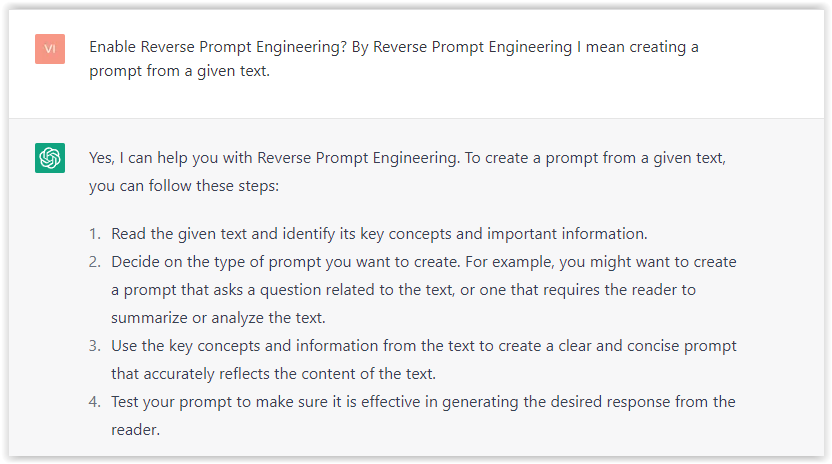 Screenshot from ChatGPT, March 2023
Screenshot from ChatGPT, March 2023You can test other GPT assistants available in the GPTs search engine if you want to use Google results.
Master Reverse Prompt Engineering
ChatGPT can be an excellent tool for reverse engineering prompts because it generates natural and engaging responses to any given input.
By analyzing the prompts generated by ChatGPT, it is possible to gain insight into the model’s underlying thought processes and decision-making strategies.
One key benefit of using ChatGPT to reverse engineer prompts is that the model is highly transparent in its decision-making.
This means that the reasoning and logic behind each response can be traced, making it easier to understand how the model arrives at its conclusions.
Once you’ve done this a few times for different types of content, you’ll gain insight into crafting more effective prompts.
Prepare Your ChatGPT For Generating Prompts
First, activate the reverse prompt engineering.
- Type the following prompt: “Enable Reverse Prompt Engineering? By Reverse Prompt Engineering I mean creating a prompt from a given text.”
 Screenshot from ChatGPT, March 2023
Screenshot from ChatGPT, March 2023ChatGPT is now ready to generate your prompt. You can test the product description in a new chatbot session and evaluate the generated prompt.
- Type: “Create a very technical reverse prompt engineering template for a product description about iPhone 11.”
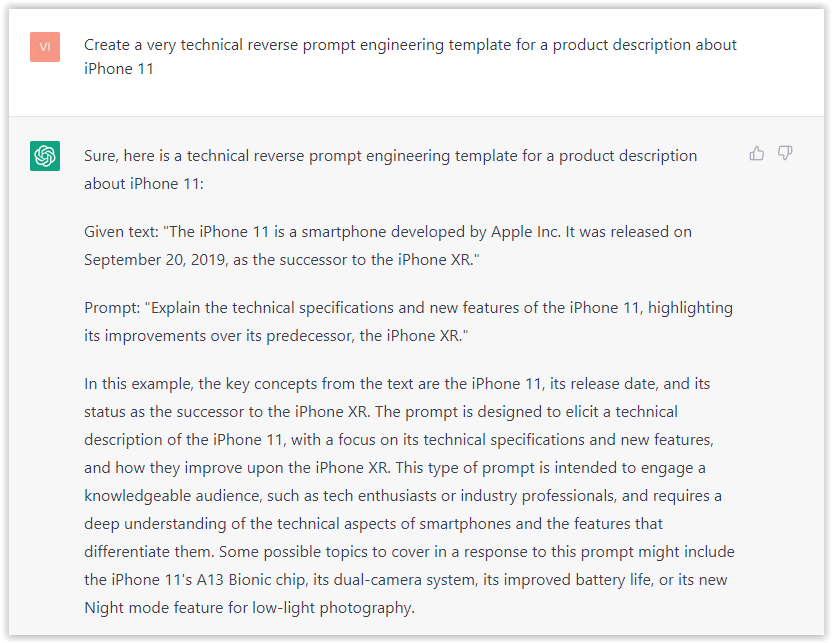 Screenshot from ChatGPT, March 2023
Screenshot from ChatGPT, March 2023The result is amazing. You can test with a full text that you want to reproduce. Here is an example of a prompt for selling a Kindle on Amazon.
- Type: “Reverse Prompt engineer the following {product), capture the writing style and the length of the text :
product =”
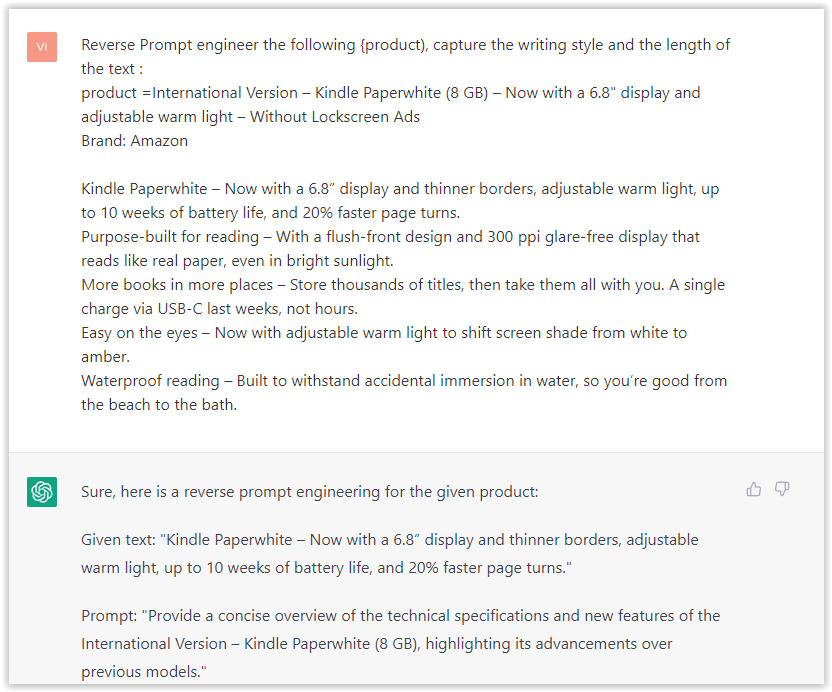 Screenshot from ChatGPT, March 2023
Screenshot from ChatGPT, March 2023I tested it on an SEJ blog post. Enjoy the analysis – it is excellent.
- Type: “Reverse Prompt engineer the following {text}, capture the tone and writing style of the {text} to include in the prompt :
text = all text coming from https://www.searchenginejournal.com/google-bard-training-data/478941/”
 Screenshot from ChatGPT, March 2023
Screenshot from ChatGPT, March 2023But be careful not to use ChatGPT to generate your texts. It is just a personal assistant.
Go Deeper
Prompts and examples for SEO:
- Keyword research and content ideas prompt: “Provide a list of 20 long-tail keyword ideas related to ‘local SEO strategies’ along with brief content topic descriptions for each keyword.”
- Optimizing content for featured snippets prompt: “Write a 40-50 word paragraph optimized for the query ‘what is the featured snippet in Google search’ that could potentially earn the featured snippet.”
- Creating meta descriptions prompt: “Draft a compelling meta description for the following blog post title: ’10 Technical SEO Factors You Can’t Ignore in 2024′.”
Important Considerations:
- Always Fact-Check: While ChatGPT can be a helpful tool, it’s crucial to remember that it may generate inaccurate or fabricated information. Always verify any facts, statistics, or quotes generated by ChatGPT before incorporating them into your content.
- Maintain Control and Creativity: Use ChatGPT as a tool to assist your writing, not replace it. Don’t rely on it to do your thinking or create content from scratch. Your unique perspective and creativity are essential for producing high-quality, engaging content.
- Iteration is Key: Refine and revise the outputs generated by ChatGPT to ensure they align with your voice, style, and intended message.
Additional Prompts for Rewording and SEO:
– Rewrite this sentence to be more concise and impactful.
– Suggest alternative phrasing for this section to improve clarity.
– Identify opportunities to incorporate relevant internal and external links.
– Analyze the keyword density and suggest improvements for better SEO.
Remember, while ChatGPT can be a valuable tool, it’s essential to use it responsibly and maintain control over your content creation process.
Experiment And Refine Your Prompting Techniques
Writing effective prompts for ChatGPT is an essential skill for any SEO professional who wants to harness the power of AI-generated content.
Hopefully, the insights and examples shared in this article can inspire you and help guide you to crafting stronger prompts that yield high-quality content.
Remember to experiment with layering prompts, iterating on the output, and continually refining your prompting techniques.
This will help you stay ahead of the curve in the ever-changing world of SEO.
More resources:
Featured Image: Tapati Rinchumrus/Shutterstock
-

 PPC6 days ago
PPC6 days ago19 Best SEO Tools in 2024 (For Every Use Case)
-

 MARKETING7 days ago
MARKETING7 days agoEcommerce evolution: Blurring the lines between B2B and B2C
-
SEARCHENGINES5 days ago
Daily Search Forum Recap: April 19, 2024
-
SEARCHENGINES6 days ago
Daily Search Forum Recap: April 18, 2024
-
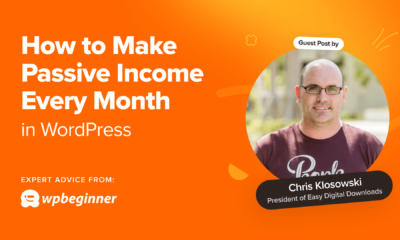
 WORDPRESS6 days ago
WORDPRESS6 days agoHow to Make $5000 of Passive Income Every Month in WordPress
-

 SEO7 days ago
SEO7 days ago2024 WordPress Vulnerability Report Shows Errors Sites Keep Making
-

 WORDPRESS7 days ago
WORDPRESS7 days ago10 Amazing WordPress Design Resouces – WordPress.com News
-

 SEO6 days ago
SEO6 days ago25 WordPress Alternatives Best For SEO








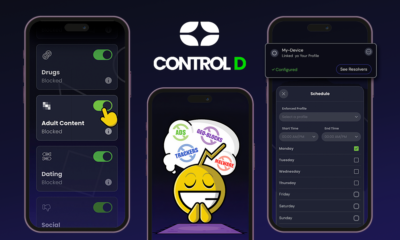







You must be logged in to post a comment Login